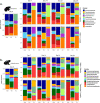Skin and gut microbiomes of tadpoles vary differently with host and water environment: a short-term experiment using 16S metabarcoding
- PMID: 37770544
- PMCID: PMC10539280
- DOI: 10.1038/s41598-023-43340-2
Skin and gut microbiomes of tadpoles vary differently with host and water environment: a short-term experiment using 16S metabarcoding
Abstract
The host-microbiome community is influenced by several host and environmental factors. In order to disentangle the individual effects of host and environment, we performed a laboratory experiment to assess the effects of the exposure to different water sources on the skin and gut microbiome of two amphibian species (Pelophylax perezi and Bufo spinosus). We observed that the bacterial communities greatly varied with water environment and host identity. Tadpoles of B. spinosus collected from a waterbody with poorer bacterial diversity exhibited a more diverse skin and gut microbiome after exposed to a richer water source. Tadpoles of P. perezi, originally collected from a richer water environment, exhibited less marked alterations in diversity patterns independently of the water source but showed alterations in gut composition. These results highlight that environment alterations, such as the water source, combined with the host effect, impact the microbiome of amphibian species in different ways; the population history (e.g., previous water environment and habitat) of the host species may also influence future alterations on tadpole microbiome.
© 2023. Springer Nature Limited.
Conflict of interest statement
The authors declare no competing interests.
Figures





References
-
- Jiménez RR, Sommer S. The amphibian microbiome: natural range of variation, pathogenic dysbiosis, and role in conservation. Biodivers. Conserv. 2017;26:763–786. doi: 10.1007/s10531-016-1272-x. - DOI
-
- Lam BA, Walke JB, Vredenburg VT, Harris RN. Proportion of individuals with anti-Batrachochytrium dendrobatidis skin bacteria is associated with population persistence in the frog Rana muscosa. Biol. Conserv. 2010;143:529–531. doi: 10.1016/j.biocon.2009.11.015. - DOI
Publication types
MeSH terms
Substances
LinkOut - more resources
Full Text Sources

